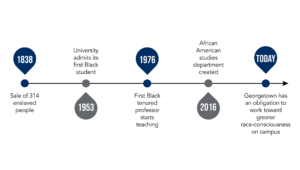This editorial is Part Three of a four-part series in honor of Black History Month where the editorial board discusses ways in which Georgetown must atone for its history of racism and change the culture of the university when it comes to race. For more, see Part One and Part Two.
As an editorial board this month, we have been advocating for Georgetown to transform its approach to race. We have called for monuments to slavery to be torn down and for the university to commit serious resources to educating its students in the university’s history of racism, the country’s history of racism, and the abounding achievements of people of color in the face of such hatred.
Clearly, the university must change on an institutional level. But this should not eclipse the fact that for most students, conversations about race occur on an individual level. Radically improving the way we address race ultimately relies on real, singular persons, not abstract systems. Professors, the individuals with the most power to guide these conversations on a daily basis, are a key component in a movement away from racism at Georgetown. However, right now, professors are all too often stumbling their way around a topic they have not been trained to discuss, harming BIPOC students in the process.
Professors hold a great degree of power in their classrooms—they decide who to call on, who to give space and recognize, which points to legitimize. They can uplift BIPOC voices calling for change and institutional reckoning, but they also can allow racist tropes to be repeated and even buy into those tropes themselves.
Given this extreme power, professors need individual training in holding conversations about race. And when the training fails, they need to be held accountable.
It is no secret that Georgetown’s faculty is extremely white and has been since the university’s founding. Many professors come from a small group of elite, and also predominantly white, universities, where race has historically gone unaddressed. This underrepresentation of BIPOC voices in academia at the university is unacceptable, and Georgetown must work to hire faculty of color, not just in entry level positions but to be tenured professors, deans, and university administrators. By refusing to provide opportunities for BIPOC academics, we are reproducing the very structures of racism we critique.
However, Georgetown’s status as a predominantly white institution will not change for some time, and with this lack of diversity comes a lack of lived experience from professors that can be applied towards discussing race in a thoughtful manner, either in personal or academic settings.
This dearth of experience is then felt by BIPOC students, who enter classroom spaces that range from unwelcoming to dehumanizing. There have been too many instances to count, some of which have been reported by the Voice, where professors have used racist language or taken discriminatory actions towards BIPOC students. Even beyond the fraction of incidents that end up getting reported, BIPOC students face implicit racism in the classroom every day when professors systematically fail to call on them, continuously butcher their names despite correction, minimize their experiences, and come to class unequipped to discuss race and identity.
For professors who do not teach classes focused on race or with units dedicated to it (which is its own failing—all disciplines interact with race and must examine how they are complicit in upholding racial structures), the only time they are explicitly asked to discuss racism in the classroom is on Martin Luther King Jr. Day through Georegtown’s Teach the Speech initiative. This little-publicized event encourages professors to teach one of King’s speeches, but does not require students to confront current manifestations of racism or Georgetown’s complicity in it. Though Teach the Speech Day is necessary, it falls far short of what is actually needed for students to have productive conversations about race in the classroom.
The day is not mandatory or publicized, meaning most students—including many members of this editorial board—go all four years without ever having a professor participate in the program. Those who Teach the Speech are not required to be trained in discussing race and racism in the classroom, which can lead to professors sanitizing King’s speeches for white audiences or ignoring the continued racism permeating our campus and society.
As part of its MLK Day planning, Georgetown must include mandatory training sessions for all professors on how to discuss race in the classroom in a way that is not harmful to BIPOC students and views the civil rights movement as not a historic event but a continued struggle. These could be led by departments, who could help professors connect the speech to their subject matter and remind students that it is not only history or humanities majors who must study racism—even if it is not at play in a field of study, it certainly is in the professional space. Training should include how to introduce the topic and set ground rules for discussions, moderate conversations, and respond to any instances of racism or bias. Professors should also work with each other to practice leading these conversations, so they aren’t doing it for the first time with students.
But one day a year cannot be enough. This training must also serve as a jumping-off point to encourage professors to more regularly bring race into their classroom, not as just one class or unit, but as a concept intertwined with their fields of study. This would certainly have to be accompanied by additional preparation and the university should ensure professors are receiving comprehensive training each semester.These efforts must include education about the racism faced by all marginalized racial groups, implicit racism that has been accepted as “normal,” and specific strategies to combat racism in the classroom. Outside of this, professors must attend conversations about racial justice and read materials about anti-racism.
Professors could ensure they spark these conversations by bringing racially diverse perspectives into the classroom through the writings of BIPOC and non-Western individuals. The School of Foreign Service has already worked to develop a self-review tool for professors to identify biases in their syllabi and evaluate author, subject, and methodological diversity. If professors were required to use such a tool or have their syllabi reviewed by an outside party, the university could ensure that each class properly addressed race and its intersection with the subject matter, and highlighted BIPOC voices throughout the semester, not just when discussing race or racism.
While it is absolutely essential we bring conversations about race into the classroom and train professors to lead those conversations, we cannot pretend all Georgetown professors will be equipped or even willing to do so in a considerate and anti-racist manner—we know they are not doing so now. These failings cannot go unaddressed.
When professors are outright racist in the classroom, students can report them to the university via the Office for Institutional Diversity, Equity & Affirmative Action (IDEAA). The reporting form allows university members to report “discriminatory, harassing, or retaliatory” actions that violate university policies, including non-discrimination in education policies, affirmative action policy, the policy statement on harassment, and the policy on sexual misconduct.
While this reporting mechanism is useful, it misses the discriminatory and racist experiences BIPOC students face in the classroom every day. Sometimes instances may not rise to the standards the university sets for what constitutes “harassment” or abjectly seem like “discrimation”, but may still perpetuate racism. Others may reveal an inability by the professor to lead conversations about race. If a professor makes a small but racially insensitive comment, the bias reporting mechanism may be too blunt a tool—yet this feedback still must be communicated in a way that will not bring about retaliation towards students. In order to ensure students are truly getting an anti-racist education, there must be a way to report and handle such instances.
This alternative reporting system, working in conjunction with the existing bias reporting mechanism, would have two parts. First, there should be a form that goes to each professor where students can leave anonymous feedback throughout the semester about discussions, especially discussions about race. If a student feels that a professor has not handled a topic adeptly or wants them to consider another perspective, they could submit feedback anonymously with the hope professors would use it to improve future discussions. All this feedback should also be sent to the IDEAA office for review. This office should not be overburdened, and if the program creates significantly more work, should hire an additional staff member.
Second, the university should maintain an additional reporting form through the IDEAA office where students can submit concerns about professors who fail to adequately lead conversations about race or allow racist ideas to be perpetuated in the classroom. This form would not necessarily lead to punishment or an investigation, as the current bias form does, but to additional training and department conversations for professors who students consistently raise concerns about. This would not replace the form which can lead to disciplinary actions against professors, it is intended for instances that call for reeducation; not reprimanding..
Both these forms should be easily accessible, well-publicized by the university, included in all syllabi, and designed to minimize the trauma associated with reporting.
With this form, white and non-Black students can also serve as allies to their peers by reporting racist incidents they witness, even when they are not the targets. White students should not leave the burden of reporting racial insensitivity to BIPOC students; we all have to play a part in promoting an inclusive learning culture and integrating anti-racism into our education.
We know that education is not just the classes we take, but the patterns of interaction we engage in.Those patterns, set up and led by professors, can reinforce racism, or attempt to fight against it. Anti-racism must be a core element of the classroom setting both to ensure BIPOC students feel welcome in Georgetown’s academic culture and to halt the reproduction of racism in academia. Professors have the obligation to create such an environment and they must be given the opportunities and skills to do so. However, we as students must be able to hold them accountable when they fail.





